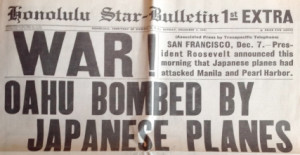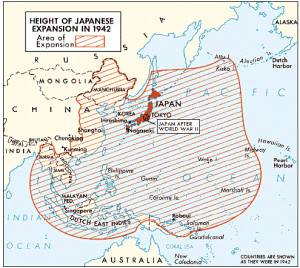
Japanese Timeline
From Chalmers Johnson’s Looting of Asia:
“It may be pointless to try to establish which World War II Axis aggressor, Germany or Japan, was the more brutal to the peoples it victimized. The Germans killed six million Jews and 20 million Russians; the Japanese slaughtered as many as 30 million Filipinos, Malays, Vietnamese, Cambodians, Indonesians and Burmese, at least 23 million of them ethnic Chinese. Both nations looted the countries they conquered on a monumental scale, though Japan plundered more, over a longer period, than the Nazis. Both conquerors enslaved millions and exploited them as forced laborers – and as was the case with the Japanese, they used their women slaves as forced prostitutes for front line troops.”
December 25, 1926: Hirohito became Emperor of Japan.
After his father, Emperor Taishō, died and Hirohito ascended the throne a zealous nationalism slowly began to take root. Old feudal loyalties were gradually replaced by loyalty to the nation as a whole, led by Hirohito. General Sadao Araki said, “It is Japan’s mission to be supreme in Asia, the South Seas and eventually the four corners of the world.” Teachers, politicians and priests were asked to indoctrinate civilians with Hirohito’s ultra-nationalist beliefs. One of which was Bushido, “The Way of the Warrior.” Bushido, based upon the Samurai moral code, stressed among other things, death before dishonor. During Japanese expansion in the South Pacific, Bushido was incorporated into their military, to present war as purifying and death a duty. Surrender was neither honorable nor an option.
May 3, 1928: The Jinan Incident. Japanese expansion began.
China was a land of feudal warlords not unlike Japan prior to Hirohito’s reign. Chinese provincial rulers were constantly at odds with one another. During the 1920’s Japan took advantage of this inner turmoil and began to expand their influence into Manchuria. Chiang Kai-shek, leader of the Nationalist Chinese Party, hoped to build a coalition and unite the factious provinces. Fearful of an alliance between Chiang and Zhang Zuolin, one of the most powerful warlords in Manchuria, the Japanese sent troops into Jinan, the capital of Shandong, south of Manchuria. Both Chinese leaders objected. Chiang sent in negotiators, whom the Japanese promptly killed. A limited skirmish ensued in which Chiang’s troops retreated from the area after suffering thousands of casualties to both troops and civilians.
June 4, 1928: Zhang Zuolin is assassinated.
A train carrying Zhang was blown up by the Japanese military and the Manchurian leader is killed, eliminating a major obstacle in Japanese plans for a foothold in China.
September 18, 1931: The Manchurian Incident.
Japan staged a false bombing against a Japanese-owned railroad near Mukden in Manchuria, and blamed Chinese dissidents for the attack. Using this as a pretext, the Japanese invaded Manchuria. Chinese forces were overwhelmed.
February 27, 1932: A Japanese puppet state is created.
Fighting in Manchuria between China and Japan ended with Japan in control. Japan created a puppet state, Manchukuo, out of occupied Manchuria.
January 1, 1933: Japan attacked the fortified eastern end of the Great Wall of China in Rehe Province of Inner Mongolia. Rehe Province would be annexed to Manchukuo.
March 27, 1933: The League of Nations’ Lytton Report found that Manchuria belonged to China and that Manchukuo was not a truly independent state. The League ordered Japan to leave Manchuria. Japan left the League of Nations instead.
May 31, 1933: The Tanggu Truce.
A truce is signed between China and Japan, setting the ceasefire conditions between the two countries after the Japanese occupation of Manchuria. China acceded to all Japanese demands, which created a large demilitarized zone inside Chinese territory.
November 14, 1936: The Suiyuan Campaign began.
Mongolian troops, backed by the Japanese, attacked the Chinese garrison at Hongort but failed in capturing it.
July 8, 1937: Japan attacked the Marco Polo Bridge near Wanping. The Chinese were able to hold the bridge and a truce was negotiated where Japan apologized for the incident, but tension continued until full scale fighting erupted once again on July 25. The Chinese were eventually defeated. This would mark the beginning of all out war between Japan and China.
December 8, 1937: Japan established the puppet state of Mengjiang in the Inner Mongolia region of China.
December 13, 1937: Japanese captured the Chinese city of Nanking.
The people of Nanking were subjected to an uncontrolled butchery that came to be known as “The Rape of Nanking.” As Imperial Japanese troops poured into the city, fleeing residents were shot or bayoneted. Thousands of Chinese soldiers were apprehended and led to killing fields where they were shot, beheaded, used for bayonet practice or killed in some other gruesome manner before being dumped into mass graves. Others were buried alive. Rape was rampant. Chinese women were repeatedly forced into brutal sex and often murdered once the lust of their attackers had been satisfied. The carnage lasted for six weeks and took an estimated 40,000 lives.
September 27, 1940: Germany negotiated a treaty with Japan. Japan along with Germany and Italy became the “Axis Powers.”
June 7, 1941: President Roosevelt acquiesced to Churchill’s repeated pleas for assistance and sent the Sixth Marine Regiment, part of the First Marine Brigade, to Iceland replacing British troops stationed there – troops needed back home to prepare for Germany’s anticipated cross-channel invasion.
July 4, 1941: Japanese planes raided the Chinese capital at Chungking.
On the same day, Emperor Hirohito sent congratulations to President Roosevelt on the anniversary of American Independence.
Also, Australian Minister to the United States, Richard Casey, stated: “Please don’t make any mistake about it. We Australians don’t go to war because of some European dispute. We went to war because we realized that if every one of us didn’t stand by Britain and throw ourselves across the track of Hitler, Mussolini and Hirohito’s juggernaut, the writing was on the wall for Democracy, our way of life, and for the world.”
July 7, 1941: The Imperial Navy of Japan announced that they were prepared to shoot down Americans and other foreigners flying in the Nationalist Chinese Air Force.
July 8, 1941: Japan carried out another air heavy raid on the Chinese capital of Chungking.
In another part of the world on the same date, the Sixth Marine Regiment landed in Iceland.
July 9, 1941: During a Japanese air raid on Chunking, the British Embassy was destroyed.
July 17, 1941: The British Commander-in-Chief in the Far East stated, “The British here are ready for whatever may happen.”
July 22, 1941: Roosevelt warned Congress, “America is in grave danger.”

December 7, 1941: Japanese forces bombed Pearl Harbor.
In concert with Pearl Harbor, they also attacked Malaya, Hong Kong, Guam, the Philippine Islands, Wake Island and Midway Island. Captain Raymond Murray broke the news to his company of Sixth Marines at the Swimming Hall in Reykjavik, “We’re in for a fight, boys. Semper Fi.”
December 8, 1941: In an address to Congress Roosevelt declared that a state of war now existed between the United States and the Empire of Japan.
December 25, 1941: Japanese claimed Wake Island. Hong Kong surrendered.
January 23, 1942: Japan began to invade New Guinea, less than 100 miles from Australia.
January 24, 1942: Over one month into the war, there was nothing but grim news from the Pacific.
Hong Kong had surrendered.
On Wake, a force of 400 Marines had withstood a two week siege, and then fell.
Japan overran the defending garrison of Marines on Guam.
Midway had taken a beating.
General MacArthur’s hold on the Philippines was slipping away.
Every important American possession west on Honolulu had been taken by the Japanese.
The Japanese Empire in the summer of 1942, from ww2maq.weebly.com
March 11, 1942: Fearing MacArthur might be captured, Roosevelt ordered him to leave the Philippines.
April 9, 1942: US Forces on Bataan in the Philippines surrendered. The Bataan Death March began.
Once the surrender went into effect, the Japanese rounded up the Allied soldiers and they began a brutal march of 60 miles across the Bataan Peninsula. The prisoners received no mercy. Disease, Japanese cruelty, exposure to the blazing sun, lack of food, and lack of water took the lives of many along the way. Of the approximate 60,000 prisoners, 7,000 to 10,000 men died or were killed on the six day march—the exact number is not known.
In the summer of 1943, when the United States government learned of what occurred, they considered the information so inflammatory that they kept the details of the Bataan Death March from becoming public knowledge until January of 1944.
April 18, 1942: The Doolittle Raid.
The USS Hornet infiltrated deep within enemy waters to launch sixteen B-25 bombers. The dangerous mission, an air raid over the Japanese mainland, was led by Lt Colonel Doolittle. The raid achieved only moderate damage but it was an embarrassment for the Japanese and proved their homeland to be vulnerable. The bombers, lacking fuel for the return voyage, crash landed in the China Sea. Ten airmen were declared missing.
March 14, 1942: Elements of the Sixth Marine Regiment left Iceland aboard the USS McCawley, en route to San Diego where the Marines would begin training for war in the Pacific at Camp Elliott.
May 3, 1942: Japanese invaded Tulagi in the Solomon Islands.
Japan moved into the Solomon Islands, only the distance of a trip from Chicago to Los Angeles away from New Zealand. In an attempt to isolate Australia and New Zealand from the United States, the Japanese began to establish military bases on Guadalcanal and surrounding islands. The strategy also called for the rapid capture of Port Moseby, New Guinea.
May 4-8: The Battle of the Coral Sea.
Allied codebreakers discovered the Japanese plan to invade Port Moseby. Having learned of the attack, Admiral Nimitz ordered an American-Australian force to engage the Japanese. The battle of the Coral Sea ensued. During the four day battle, the USS Lexington was sunk and the USS Yorktown sustained serious damage. Although the American loses were greater than the Japanese, the invasion force was turned back, making it a strategic victory for the Allies.
May 31-June 8, 1942: Japanese submarines attack the Australian cities of Sydney and Newcastle.
June 4-7, 1942: The Battle of Midway.
The Japanese set a trap for the US Navy at Midway. They wanted to destroy what was left of the US Fleet, eliminating America as a power in the Pacific and capturing the Midway Atoll. Once Midway was taken, the Japanese would invade Hawaii. Allied codebreakers once again discovered the attack and the US Fleet set an ambush which resulted in a decisive defeat of the Japanese Imperial Navy.
June 7, 1942: Japan invaded the Alaskan islands of Attu and Kiska.
July 7, 1942: Japanese expansion southward now included Guadalcanal in the Solomons. Reconnaissance planes discovered an airfield being built near Lunga Point. When completed, the airfield would threaten Australia, New Zealand and the entire security of the South Pacific.
August 7, 1942: US Marines invaded Guadalcanal, Tulagi, Tanambogo and Gavutu in the Solomon Islands.
August 17, 1942: Marine Raiders invaded Makin in the Gilbert Islands.
As a diversionary tactic, a 200 man contingent of a Marine Raider Battalion was sent deep into enemy territory to draw Japanese attention away from Guadalcanal. They invaded the fortified island of Makin in the Gilbert Islands. Reaching shore before dawn by rubber boats, the Raiders wrought havoc and destroyed enemy installations. After accomplishing their mission, the evacuation to submarines offshore became difficult due to heavy seas.
Nine Raiders didn’t make it off the island, eventually being captured by the Japanese and beheaded.
October 20, 1942: The Sixth Marine Regiment left San Diego for war in the Pacific.
January 4, 1943: The Sixth Marine Regiment landed on Guadalcanal, replacing the battle wearied and malarial Marines on the island and continued the fight against the Imperial Army.
February 9, 1943: Guadalcanal was declared secure. The final toll for Guadalcanal: Marine dead, more than 1200 with over 2800 wounded and 140 missing. Japanese deaths totaled approximately 25,000.
February 19, 1943: Leaving Guadalcanal aboard the USS Adams and two other ships, the Sixth Marines were sent to New Zealand to rest and prepare for the next battle.
April 22, 1943: Japan announced “Captured Allied pilots will be given a one-way ticket to hell” after executing several airmen from the Doolittle Raid.
August 15, 1943: An Allied invasion force of over thirty thousand landed on the Japanese held Aleutian island of Kiska, only to find that the Imperial Army had fled.
November 1, 1943: Part of the largest armada ever assembled, the Sixth Marine Regiment left New Zealand heading north. Sergeant Bill Knuppel aboard the USS Franklin Bell wrote “At nine in the morning we left the Bay of Wellington and New Zealand for the last time. The ocean is like glass.”
November 20, 1943: US Marines invaded the Japanese stronghold, Tarawa.
November 23, 1943: Tarawa was declared secure. Knuppel noted in his diary, “Marines killed on Tarawa 2200. Marines wounded on Tarawa 2100. Japs killed on Tarawa 5000. All this within 74 hours of fighting.” The Sixth Marine Regiment left Bloody Tarawa in three ships, arriving at Parker Ranch in Hawaii at various times in December 1943.
January 11, 1944: The story of 40 Thieves on Saipan begins.


